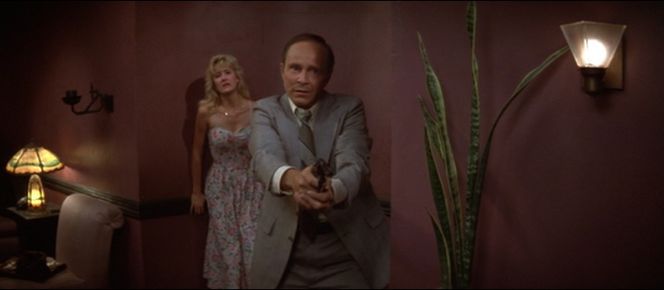 Back to selection
Back to selection
The Blue Velvet Project
Blue Velvet, 47 seconds at a time by Nicholas Rombes
The Blue Velvet Project, #147

Second #6909, 115:09
Detective Williams arrives, too late. Everyone dead is dead. Jeffrey is alive, but not because of the Law. Sandy, behind her father, behind the gun, swoons, electrified and ready to be taken by Jeffrey. This post is as good a post as any to suggest that, just beneath its surface, Blue Velvet is a “trash” film. It’s so overloaded with references to Hollywood’s traditions that always threatens to implode in on itself, perhaps nowhere else more poignantly than in this frame, which evokes everything from noir to the “woman’s picture” to the classic crime film. In Avant-Garde Film: Motion Studies, Scott MacDonald writes about avant-garde “trash” films of the 60s and 70s:
The films designated by the term [“trash”] develop recognizable narratives, with characters, sets, costumes—all the fundamental elements of Hollywood movie-making; but either because the filmmakers lack the economic means for achieving industry-level production values, or because of their decision to use their limited resources to affront conventional expectations by painstakingly constructing a trashy look, viewers of trash films are continually aware of the gaps between this rendition of a story and the way a story would be handled by an industry director.
But Blue Velvet is not a trash film in the usual sense. It’s always seemed to me completely non-ironic, though I know that for many, it’s impossible to watch without laughing at Sandy’s weepy innocence, or Detective Williams’s “detectivey” qualities, or even Frank’s super-villain villainy. But assuming that Blue Velvet is as sincere as Jeffrey—who does, after all, seem to represent the film’s basic world-view—then it’s a trash film not because of any overt parody or mockery of Hollywood’s genres, but because, in the words of MacDonald, its “recognizable narratives, with characters, sets, costumes” trigger in the viewer an uneasy sense that we’ve seen this before, and that in seeing it again, recycled but for different emotional purposes, we are being manipulated in ways that we can detect but can’t quite define.
If trash films as MacDonald describes them deliberately foreground their recycled Hollywood elements, Blue Velvet seems to obscure its intentions on that score, and the result is a film that wrests a weird range of emotional responses from the audience. The frame at second #6909 is a good example. It comes at a moment of such high drama that the absurd fact that Sandy is actually there trailing along with her dad on such a dangerous mission is easily forgotten later. And yet there she is, in her dress, at night, in Dorothy’s apartment, the blood and brains of three murdered men soaking into the carpeting. Oh Sandy, Sandy. There is no robin anywhere, in this world or another, that could put an end to people like Frank.
Over the period of one full year — three days per week — The Blue Velvet Project will seize a frame every 47 seconds of David Lynch’s classic to explore. These posts will run until second 7,200 in August 2012. For a complete archive of the project, click here. And here is the introduction to the project.
